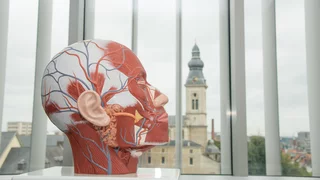
Innovation in mime therapy: development of a digital exercise platform
Mime therapy is an internationally distributed and evidence-based treatment method for people with facial paralysis (Beurskens & Heymans, 2006). The therapy is currently offered in its classic form on paper. A digital exercise package with the implementation of innovative technology could make the rehabilitation process more effective and efficient.

Introduction
E-health can be described as the application of information and communication technology within the wide range of healthcare activities (Vukovic et al., 2018). It can replace or supplement traditional personal health care. When implementing an eHealth intervention, the wishes of the end user must be carefully considered (Kloek et al., 2017). The aim of this study was therefore initially to assess the needs, requirements, facilitators and barriers of an e-health application in mime therapy from the perspective of mime therapists and patients with facial paralysis. Secondly, the experiences and reflections regarding a prototype digital mime therapy exercise package were explored.
Method
A descriptive qualitative study was conducted in conjunction with developmental research. 12 mime therapists and 12 patients in the Netherlands and Flanders were interviewed on the basis of a predetermined topic list. After verbal transcription, all interviews were analyzed according to the principles of thematic analysis.
At the same time, a digital exercise package was developed based on the existing therapy bundle, which was tested in the meantime with all stakeholders. After implementation in an existing exercise platform, this exercise material was tested by mime therapists and patients for two months. Their experiences were collected through a focus group discussion (6 therapists) and in-depth interviews (5 patients).
Results
Analysis of the interviews confirms a very positive receptivity to e-health within mime therapy with great potential in assessment, education and treatment. A number of crucial opportunities turned out to be higher therapy compliance, better accessibility to mime therapy, empowerment, privacy, visualization of evolution and the possibility of individualization. Pitfalls cited were the cost price, less personal and physical contact, poor design and discrimination against specific target groups. All stakeholders emphasized the importance of blended care in which the therapist must continue to play a guiding role. The prototype exercise package was generally positively received as an important support in practicing more often and more correctly. A number of crucial challenges for further development are digital test administration, recognisability, automatic feedback options, implementation of more variation, context, surprise and game element.
Discussion and conclusion
There is broad support for e-health within mime therapy in the form of blended care. The developed exercise material in its current form can be used in the treatment of people with peripheral facial paralysis. The analysis of the feedback forms the basis for the further development and implementation of innovative technology and expansion to a broader target group in mime therapy.
Research realisations and publications

Poster
E-Health in mime therapy: qualitative research into the perspective of therapist and patient.

Poster
Innovation in mime therapy: development of a digital exercise platform from the perspective of therapist and patient.
Meet the researcher
Work with us?
Request customised research
We are happy to help you formulate your research question and approach.





